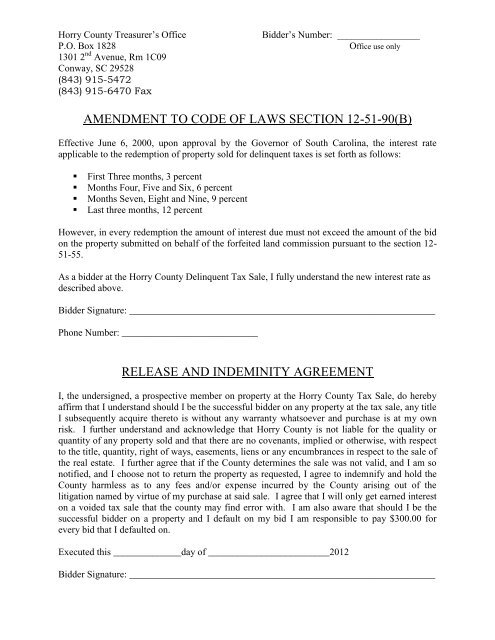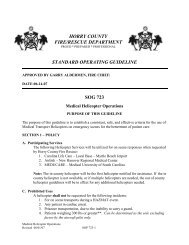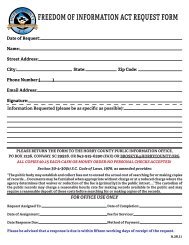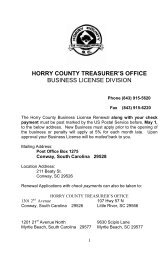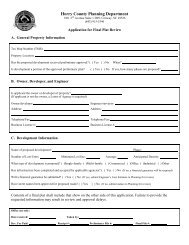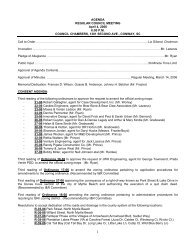PDF Bidder Application - Horry County Government
PDF Bidder Application - Horry County Government
PDF Bidder Application - Horry County Government
You also want an ePaper? Increase the reach of your titles
YUMPU automatically turns print PDFs into web optimized ePapers that Google loves.
<strong>Horry</strong> <strong>County</strong> Treasurer’s OfficeP.O. Box 18281301 2 nd Avenue, Rm 1C09Conway, SC 29528(843) 915-5472(843) 915-6470 Fax<strong>Bidder</strong>’s Number: _________________Office use onlyAMENDMENT TO CODE OF LAWS SECTION 12-51-90(B)Effective June 6, 2000, upon approval by the Governor of South Carolina, the interest rateapplicable to the redemption of property sold for delinquent taxes is set forth as follows:• First Three months, 3 percent• Months Four, Five and Six, 6 percent• Months Seven, Eight and Nine, 9 percent• Last three months, 12 percentHowever, in every redemption the amount of interest due must not exceed the amount of the bidon the property submitted on behalf of the forfeited land commission pursuant to the section 12-51-55.As a bidder at the <strong>Horry</strong> <strong>County</strong> Delinquent Tax Sale, I fully understand the new interest rate asdescribed above.<strong>Bidder</strong> Signature: _______________________________________________________________Phone Number: ____________________________RELEASE AND INDEMINITY AGREEMENTI, the undersigned, a prospective member on property at the <strong>Horry</strong> <strong>County</strong> Tax Sale, do herebyaffirm that I understand should I be the successful bidder on any property at the tax sale, any titleI subsequently acquire thereto is without any warranty whatsoever and purchase is at my ownrisk. I further understand and acknowledge that <strong>Horry</strong> <strong>County</strong> is not liable for the quality orquantity of any property sold and that there are no covenants, implied or otherwise, with respectto the title, quantity, right of ways, easements, liens or any encumbrances in respect to the sale ofthe real estate. I further agree that if the <strong>County</strong> determines the sale was not valid, and I am sonotified, and I choose not to return the property as requested, I agree to indemnify and hold the<strong>County</strong> harmless as to any fees and/or expense incurred by the <strong>County</strong> arising out of thelitigation named by virtue of my purchase at said sale. I agree that I will only get earned intereston a voided tax sale that the county may find error with. I am also aware that should I be thesuccessful bidder on a property and I default on my bid I am responsible to pay $300.00 forevery bid that I defaulted on.Executed this ______________day of _________________________2012<strong>Bidder</strong> Signature: _______________________________________________________________
Form W-9(Rev. December 2011)Department of the TreasuryInternal Revenue ServiceName (as shown on your income tax return)Request for TaxpayerIdentification Number and CertificationGive Form to therequester. Do notsend to the IRS.Print or typeSee Specific Instructions on page 2.Business name/disregarded entity name, if different from aboveCheck appropriate box for federal tax classification:Individual/sole proprietor C Corporation S Corporation Partnership Trust/estateExempt payeeLimited liability company. Enter the tax classification (C=C corporation, S=S corporation, P=partnership) ▶Other (see instructions) ▶Address (number, street, and apt. or suite no.)Requester’s name and address (optional)City, state, and ZIP codeList account number(s) here (optional)Part I Taxpayer Identification Number (TIN)Enter your TIN in the appropriate box. The TIN provided must match the name given on the “Name” lineto avoid backup withholding. For individuals, this is your social security number (SSN). However, for aresident alien, sole proprietor, or disregarded entity, see the Part I instructions on page 3. For otherentities, it is your employer identification number (EIN). If you do not have a number, see How to get aTIN on page 3.Note. If the account is in more than one name, see the chart on page 4 for guidelines on whosenumber to enter.Social security number– –Employer identification numberPart II CertificationUnder penalties of perjury, I certify that:1. The number shown on this form is my correct taxpayer identification number (or I am waiting for a number to be issued to me), and2. I am not subject to backup withholding because: (a) I am exempt from backup withholding, or (b) I have not been notified by the Internal RevenueService (IRS) that I am subject to backup withholding as a result of a failure to report all interest or dividends, or (c) the IRS has notified me that I amno longer subject to backup withholding, and3. I am a U.S. citizen or other U.S. person (defined below).Certification instructions. You must cross out item 2 above if you have been notified by the IRS that you are currently subject to backup withholdingbecause you have failed to report all interest and dividends on your tax return. For real estate transactions, item 2 does not apply. For mortgageinterest paid, acquisition or abandonment of secured property, cancellation of debt, contributions to an individual retirement arrangement (IRA), andgenerally, payments other than interest and dividends, you are not required to sign the certification, but you must provide your correct TIN. See theinstructions on page 4.SignHereSignature ofU.S. person ▶General InstructionsSection references are to the Internal Revenue Code unless otherwisenoted.Purpose of FormA person who is required to file an information return with the IRS mustobtain your correct taxpayer identification number (TIN) to report, forexample, income paid to you, real estate transactions, mortgage interestyou paid, acquisition or abandonment of secured property, cancellationof debt, or contributions you made to an IRA.Use Form W-9 only if you are a U.S. person (including a residentalien), to provide your correct TIN to the person requesting it (therequester) and, when applicable, to:1. Certify that the TIN you are giving is correct (or you are waiting for anumber to be issued),2. Certify that you are not subject to backup withholding, or3. Claim exemption from backup withholding if you are a U.S. exemptpayee. If applicable, you are also certifying that as a U.S. person, yourallocable share of any partnership income from a U.S. trade or businessis not subject to the withholding tax on foreign partners’ share ofeffectively connected income.Date ▶Note. If a requester gives you a form other than Form W-9 to requestyour TIN, you must use the requester’s form if it is substantially similarto this Form W-9.Definition of a U.S. person. For federal tax purposes, you areconsidered a U.S. person if you are:• An individual who is a U.S. citizen or U.S. resident alien,• A partnership, corporation, company, or association created ororganized in the United States or under the laws of the United States,• An estate (other than a foreign estate), or• A domestic trust (as defined in Regulations section 301.7701-7).Special rules for partnerships. Partnerships that conduct a trade orbusiness in the United States are generally required to pay a withholdingtax on any foreign partners’ share of income from such business.Further, in certain cases where a Form W-9 has not been received, apartnership is required to presume that a partner is a foreign person,and pay the withholding tax. Therefore, if you are a U.S. person that is apartner in a partnership conducting a trade or business in the UnitedStates, provide Form W-9 to the partnership to establish your U.S.status and avoid withholding on your share of partnership income.Cat. No. 10231X Form W-9 (Rev. 12-2011)–
Form W-9 (Rev. 12-2011) Page 2The person who gives Form W-9 to the partnership for purposes ofestablishing its U.S. status and avoiding withholding on its allocableshare of net income from the partnership conducting a trade or businessin the United States is in the following cases:• The U.S. owner of a disregarded entity and not the entity,• The U.S. grantor or other owner of a grantor trust and not the trust,and• The U.S. trust (other than a grantor trust) and not the beneficiaries ofthe trust.Foreign person. If you are a foreign person, do not use Form W-9.Instead, use the appropriate Form W-8 (see Publication 515,Withholding of Tax on Nonresident Aliens and Foreign Entities).Nonresident alien who becomes a resident alien. Generally, only anonresident alien individual may use the terms of a tax treaty to reduceor eliminate U.S. tax on certain types of income. However, most taxtreaties contain a provision known as a “saving clause.” Exceptionsspecified in the saving clause may permit an exemption from tax tocontinue for certain types of income even after the payee has otherwisebecome a U.S. resident alien for tax purposes.If you are a U.S. resident alien who is relying on an exceptioncontained in the saving clause of a tax treaty to claim an exemptionfrom U.S. tax on certain types of income, you must attach a statementto Form W-9 that specifies the following five items:1. The treaty country. Generally, this must be the same treaty underwhich you claimed exemption from tax as a nonresident alien.2. The treaty article addressing the income.3. The article number (or location) in the tax treaty that contains thesaving clause and its exceptions.4. The type and amount of income that qualifies for the exemptionfrom tax.5. Sufficient facts to justify the exemption from tax under the terms ofthe treaty article.Example. Article 20 of the U.S.-China income tax treaty allows anexemption from tax for scholarship income received by a Chinesestudent temporarily present in the United States. Under U.S. law, thisstudent will become a resident alien for tax purposes if his or her stay inthe United States exceeds 5 calendar years. However, paragraph 2 ofthe first Protocol to the U.S.-China treaty (dated April 30, 1984) allowsthe provisions of Article 20 to continue to apply even after the Chinesestudent becomes a resident alien of the United States. A Chinesestudent who qualifies for this exception (under paragraph 2 of the firstprotocol) and is relying on this exception to claim an exemption from taxon his or her scholarship or fellowship income would attach to FormW-9 a statement that includes the information described above tosupport that exemption.If you are a nonresident alien or a foreign entity not subject to backupwithholding, give the requester the appropriate completed Form W-8.What is backup withholding? Persons making certain payments to youmust under certain conditions withhold and pay to the IRS a percentageof such payments. This is called “backup withholding.” Payments thatmay be subject to backup withholding include interest, tax-exemptinterest, dividends, broker and barter exchange transactions, rents,royalties, nonemployee pay, and certain payments from fishing boatoperators. Real estate transactions are not subject to backupwithholding.You will not be subject to backup withholding on payments youreceive if you give the requester your correct TIN, make the propercertifications, and report all your taxable interest and dividends on yourtax return.Payments you receive will be subject to backupwithholding if:1. You do not furnish your TIN to the requester,2. You do not certify your TIN when required (see the Part IIinstructions on page 3 for details),3. The IRS tells the requester that you furnished an incorrect TIN,4. The IRS tells you that you are subject to backup withholdingbecause you did not report all your interest and dividends on your taxreturn (for reportable interest and dividends only), or5. You do not certify to the requester that you are not subject tobackup withholding under 4 above (for reportable interest and dividendaccounts opened after 1983 only).Certain payees and payments are exempt from backup withholding.See the instructions below and the separate Instructions for theRequester of Form W-9.Also see Special rules for partnerships on page 1.Updating Your InformationYou must provide updated information to any person to whom youclaimed to be an exempt payee if you are no longer an exempt payeeand anticipate receiving reportable payments in the future from thisperson. For example, you may need to provide updated information ifyou are a C corporation that elects to be an S corporation, or if you nolonger are tax exempt. In addition, you must furnish a new Form W-9 ifthe name or TIN changes for the account, for example, if the grantor of agrantor trust dies.PenaltiesFailure to furnish TIN. If you fail to furnish your correct TIN to arequester, you are subject to a penalty of $50 for each such failureunless your failure is due to reasonable cause and not to willful neglect.Civil penalty for false information with respect to withholding. If youmake a false statement with no reasonable basis that results in nobackup withholding, you are subject to a $500 penalty.Criminal penalty for falsifying information. Willfully falsifyingcertifications or affirmations may subject you to criminal penaltiesincluding fines and/or imprisonment.Misuse of TINs. If the requester discloses or uses TINs in violation offederal law, the requester may be subject to civil and criminal penalties.Specific InstructionsNameIf you are an individual, you must generally enter the name shown onyour income tax return. However, if you have changed your last name,for instance, due to marriage without informing the Social SecurityAdministration of the name change, enter your first name, the last nameshown on your social security card, and your new last name.If the account is in joint names, list first, and then circle, the name ofthe person or entity whose number you entered in Part I of the form.Sole proprietor. Enter your individual name as shown on your incometax return on the “Name” line. You may enter your business, trade, or“doing business as (DBA)” name on the “Business name/disregardedentity name” line.Partnership, C Corporation, or S Corporation. Enter the entity's nameon the “Name” line and any business, trade, or “doing business as(DBA) name” on the “Business name/disregarded entity name” line.Disregarded entity. Enter the owner's name on the “Name” line. Thename of the entity entered on the “Name” line should never be adisregarded entity. The name on the “Name” line must be the nameshown on the income tax return on which the income will be reported.For example, if a foreign LLC that is treated as a disregarded entity forU.S. federal tax purposes has a domestic owner, the domestic owner'sname is required to be provided on the “Name” line. If the direct ownerof the entity is also a disregarded entity, enter the first owner that is notdisregarded for federal tax purposes. Enter the disregarded entity'sname on the “Business name/disregarded entity name” line. If the ownerof the disregarded entity is a foreign person, you must complete anappropriate Form W-8.Note. Check the appropriate box for the federal tax classification of theperson whose name is entered on the “Name” line (Individual/soleproprietor, Partnership, C Corporation, S Corporation, Trust/estate).Limited Liability Company (LLC). If the person identified on the“Name” line is an LLC, check the “Limited liability company” box onlyand enter the appropriate code for the tax classification in the spaceprovided. If you are an LLC that is treated as a partnership for federaltax purposes, enter “P” for partnership. If you are an LLC that has filed aForm 8832 or a Form 2553 to be taxed as a corporation, enter “C” forC corporation or “S” for S corporation. If you are an LLC that isdisregarded as an entity separate from its owner under Regulationsection 301.7701-3 (except for employment and excise tax), do notcheck the LLC box unless the owner of the LLC (required to beidentified on the “Name” line) is another LLC that is not disregarded forfederal tax purposes. If the LLC is disregarded as an entity separatefrom its owner, enter the appropriate tax classification of the owneridentified on the “Name” line.
Form W-9 (Rev. 12-2011) Page 3Other entities. Enter your business name as shown on required federaltax documents on the “Name” line. This name should match the nameshown on the charter or other legal document creating the entity. Youmay enter any business, trade, or DBA name on the “Business name/disregarded entity name” line.Exempt PayeeIf you are exempt from backup withholding, enter your name asdescribed above and check the appropriate box for your status, thencheck the “Exempt payee” box in the line following the “Business name/disregarded entity name,” sign and date the form.Generally, individuals (including sole proprietors) are not exempt frombackup withholding. Corporations are exempt from backup withholdingfor certain payments, such as interest and dividends.Note. If you are exempt from backup withholding, you should stillcomplete this form to avoid possible erroneous backup withholding.The following payees are exempt from backup withholding:1. An organization exempt from tax under section 501(a), any IRA, or acustodial account under section 403(b)(7) if the account satisfies therequirements of section 401(f)(2),2. The United States or any of its agencies or instrumentalities,3. A state, the District of Columbia, a possession of the United States,or any of their political subdivisions or instrumentalities,4. A foreign government or any of its political subdivisions, agencies,or instrumentalities, or5. An international organization or any of its agencies orinstrumentalities.Other payees that may be exempt from backup withholding include:6. A corporation,7. A foreign central bank of issue,8. A dealer in securities or commodities required to register in theUnited States, the District of Columbia, or a possession of the UnitedStates,9. A futures commission merchant registered with the CommodityFutures Trading Commission,10. A real estate investment trust,11. An entity registered at all times during the tax year under theInvestment Company Act of 1940,12. A common trust fund operated by a bank under section 584(a),13. A financial institution,14. A middleman known in the investment community as a nominee orcustodian, or15. A trust exempt from tax under section 664 or described in section4947.The following chart shows types of payments that may be exemptfrom backup withholding. The chart applies to the exempt payees listedabove, 1 through 15.IF the payment is for . . .Interest and dividend paymentsTHEN the payment is exemptfor . . .All exempt payees exceptfor 9Broker transactions Exempt payees 1 through 5 and 7through 13. Also, C corporations.Barter exchange transactions andpatronage dividendsExempt payees 1 through 5Payments over $600 required to be Generally, exempt payeesreported and direct sales over 1 through 7 2$5,000 1Part I. Taxpayer Identification Number (TIN)Enter your TIN in the appropriate box. If you are a resident alien andyou do not have and are not eligible to get an SSN, your TIN is your IRSindividual taxpayer identification number (ITIN). Enter it in the socialsecurity number box. If you do not have an ITIN, see How to get a TINbelow.If you are a sole proprietor and you have an EIN, you may enter eitheryour SSN or EIN. However, the IRS prefers that you use your SSN.If you are a single-member LLC that is disregarded as an entityseparate from its owner (see Limited Liability Company (LLC) on page 2),enter the owner’s SSN (or EIN, if the owner has one). Do not enter thedisregarded entity’s EIN. If the LLC is classified as a corporation orpartnership, enter the entity’s EIN.Note. See the chart on page 4 for further clarification of name and TINcombinations.How to get a TIN. If you do not have a TIN, apply for one immediately.To apply for an SSN, get Form SS-5, <strong>Application</strong> for a Social SecurityCard, from your local Social Security Administration office or get thisform online at www.ssa.gov. You may also get this form by calling1-800-772-1213. Use Form W-7, <strong>Application</strong> for IRS Individual TaxpayerIdentification Number, to apply for an ITIN, or Form SS-4, <strong>Application</strong> forEmployer Identification Number, to apply for an EIN. You can apply foran EIN online by accessing the IRS website at www.irs.gov/businessesand clicking on Employer Identification Number (EIN) under Starting aBusiness. You can get Forms W-7 and SS-4 from the IRS by visitingIRS.gov or by calling 1-800-TAX-FORM (1-800-829-3676).If you are asked to complete Form W-9 but do not have a TIN, write“Applied For” in the space for the TIN, sign and date the form, and giveit to the requester. For interest and dividend payments, and certainpayments made with respect to readily tradable instruments, generallyyou will have 60 days to get a TIN and give it to the requester before youare subject to backup withholding on payments. The 60-day rule doesnot apply to other types of payments. You will be subject to backupwithholding on all such payments until you provide your TIN to therequester.Note. Entering “Applied For” means that you have already applied for aTIN or that you intend to apply for one soon.Caution: A disregarded domestic entity that has a foreign owner mustuse the appropriate Form W-8.Part II. CertificationTo establish to the withholding agent that you are a U.S. person, orresident alien, sign Form W-9. You may be requested to sign by thewithholding agent even if item 1, below, and items 4 and 5 on page 4indicate otherwise.For a joint account, only the person whose TIN is shown in Part Ishould sign (when required). In the case of a disregarded entity, theperson identified on the “Name” line must sign. Exempt payees, seeExempt Payee on page 3.Signature requirements. Complete the certification as indicated initems 1 through 3, below, and items 4 and 5 on page 4.1. Interest, dividend, and barter exchange accounts openedbefore 1984 and broker accounts considered active during 1983.You must give your correct TIN, but you do not have to sign thecertification.2. Interest, dividend, broker, and barter exchange accountsopened after 1983 and broker accounts considered inactive during1983. You must sign the certification or backup withholding will apply. Ifyou are subject to backup withholding and you are merely providingyour correct TIN to the requester, you must cross out item 2 in thecertification before signing the form.3. Real estate transactions. You must sign the certification. You maycross out item 2 of the certification.1See Form 1099-MISC, Miscellaneous Income, and its instructions.2However, the following payments made to a corporation and reportable on Form1099-MISC are not exempt from backup withholding: medical and health carepayments, attorneys' fees, gross proceeds paid to an attorney, and payments forservices paid by a federal executive agency.
Form W-9 (Rev. 12-2011) Page 44. Other payments. You must give your correct TIN, but you do nothave to sign the certification unless you have been notified that youhave previously given an incorrect TIN. “Other payments” includepayments made in the course of the requester’s trade or business forrents, royalties, goods (other than bills for merchandise), medical andhealth care services (including payments to corporations), payments toa nonemployee for services, payments to certain fishing boat crewmembers and fishermen, and gross proceeds paid to attorneys(including payments to corporations).5. Mortgage interest paid by you, acquisition or abandonment ofsecured property, cancellation of debt, qualified tuition programpayments (under section 529), IRA, Coverdell ESA, Archer MSA orHSA contributions or distributions, and pension distributions. Youmust give your correct TIN, but you do not have to sign the certification.What Name and Number To Give the RequesterFor this type of account:Give name and SSN of:1. Individual The individual2. Two or more individuals (joint The actual owner of the account or,account)if combined funds, the firstindividual on the account 13. Custodian account of a minor The minor 2(Uniform Gift to Minors Act)4. a. The usual revocable savings The grantor-trustee 1trust (grantor is also trustee)b. So-called trust account that is The actual owner 1not a legal or valid trust understate law5. Sole proprietorship or disregarded The owner 3entity owned by an individual6. Grantor trust filing under Optional The grantor*Form 1099 Filing Method 1 (seeRegulation section 1.671-4(b)(2)(i)(A))For this type of account:Give name and EIN of:7. Disregarded entity not owned by an The ownerindividual8. A valid trust, estate, or pension trust Legal entity 49. Corporation or LLC electingThe corporationcorporate status on Form 8832 orForm 255310. Association, club, religious,The organizationcharitable, educational, or othertax-exempt organization11. Partnership or multi-member LLC The partnership12. A broker or registered nominee The broker or nominee13. Account with the Department of The public entityAgriculture in the name of a publicentity (such as a state or localgovernment, school district, orprison) that receives agriculturalprogram payments14. Grantor trust filing under the Form The trust1041 Filing Method or the OptionalForm 1099 Filing Method 2 (seeRegulation section 1.671-4(b)(2)(i)(B))Note. If no name is circled when more than one name is listed, thenumber will be considered to be that of the first name listed.Secure Your Tax Records from Identity TheftIdentity theft occurs when someone uses your personal informationsuch as your name, social security number (SSN), or other identifyinginformation, without your permission, to commit fraud or other crimes.An identity thief may use your SSN to get a job or may file a tax returnusing your SSN to receive a refund.To reduce your risk:• Protect your SSN,• Ensure your employer is protecting your SSN, and• Be careful when choosing a tax preparer.If your tax records are affected by identity theft and you receive anotice from the IRS, respond right away to the name and phone numberprinted on the IRS notice or letter.If your tax records are not currently affected by identity theft but youthink you are at risk due to a lost or stolen purse or wallet, questionablecredit card activity or credit report, contact the IRS Identity Theft Hotlineat 1-800-908-4490 or submit Form 14039.For more information, see Publication 4535, Identity Theft Preventionand Victim Assistance.Victims of identity theft who are experiencing economic harm or asystem problem, or are seeking help in resolving tax problems that havenot been resolved through normal channels, may be eligible forTaxpayer Advocate Service (TAS) assistance. You can reach TAS bycalling the TAS toll-free case intake line at 1-877-777-4778 or TTY/TDD1-800-829-4059.Protect yourself from suspicious emails or phishing schemes.Phishing is the creation and use of email and websites designed tomimic legitimate business emails and websites. The most common actis sending an email to a user falsely claiming to be an establishedlegitimate enterprise in an attempt to scam the user into surrenderingprivate information that will be used for identity theft.The IRS does not initiate contacts with taxpayers via emails. Also, theIRS does not request personal detailed information through email or asktaxpayers for the PIN numbers, passwords, or similar secret accessinformation for their credit card, bank, or other financial accounts.If you receive an unsolicited email claiming to be from the IRS,forward this message to phishing@irs.gov. You may also report misuseof the IRS name, logo, or other IRS property to the Treasury InspectorGeneral for Tax Administration at 1-800-366-4484. You can forwardsuspicious emails to the Federal Trade Commission at: spam@uce.govor contact them at www.ftc.gov/idtheft or 1-877-IDTHEFT(1-877-438-4338).Visit IRS.gov to learn more about identity theft and how to reduceyour risk.1 List first and circle the name of the person whose number you furnish. If only one person on ajoint account has an SSN, that person’s number must be furnished.2 Circle the minor’s name and furnish the minor’s SSN.3 You must show your individual name and you may also enter your business or “DBA” name onthe “Business name/disregarded entity” name line. You may use either your SSN or EIN (if youhave one), but the IRS encourages you to use your SSN.4 List first and circle the name of the trust, estate, or pension trust. (Do not furnish the TIN of thepersonal representative or trustee unless the legal entity itself is not designated in the accounttitle.) Also see Special rules for partnerships on page 1.*Note. Grantor also must provide a Form W-9 to trustee of trust.Privacy Act NoticeSection 6109 of the Internal Revenue Code requires you to provide your correct TIN to persons (including federal agencies) who are required to file information returns withthe IRS to report interest, dividends, or certain other income paid to you; mortgage interest you paid; the acquisition or abandonment of secured property; the cancellationof debt; or contributions you made to an IRA, Archer MSA, or HSA. The person collecting this form uses the information on the form to file information returns with the IRS,reporting the above information. Routine uses of this information include giving it to the Department of Justice for civil and criminal litigation and to cities, states, the Districtof Columbia, and U.S. possessions for use in administering their laws. The information also may be disclosed to other countries under a treaty, to federal and state agenciesto enforce civil and criminal laws, or to federal law enforcement and intelligence agencies to combat terrorism. You must provide your TIN whether or not you are required tofile a tax return. Under section 3406, payers must generally withhold a percentage of taxable interest, dividend, and certain other payments to a payee who does not give aTIN to the payer. Certain penalties may also apply for providing false or fraudulent information.


